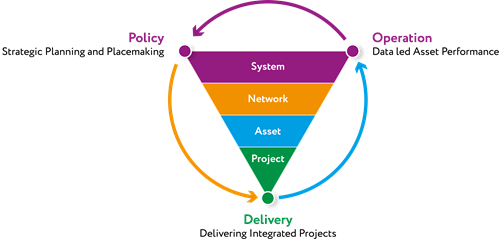C
onsultants are working in an industry which is becoming increasingly led by data and technology. New tools are constantly emerging – self-monitoring infrastructure, offsite and modular construction, drones and virtual reality – all of which enable engineers to monitor projects from their desks, undertaking digital design which takes minutes, rather than weeks.
We need to consider a move to business models which enable us to combine, and get credit for, the value that our data, our products and technological solutions – as well as our expertise – delivers to a client and their end users. It is vital for the long-term growth, productivity and sustainability of the industry and our businesses that we find a way to get a return on investment and innovation across all of our products and services.
We need to look at how we view ourselves and what our value-proposition for a client is. Traditionally, as engineers, we would work at, and earn most of our revenue at a project level. However, now, we have a plethora of data and a range of new digital tools which opens up new possibilities to advise clients on their networks, or their systems, advising on their assets, and earning fees to reflect that.

ACE’s current Future of Consultancy research, alongside existing initiatives such as Project 13, explores how we take this combination of constituent parts and sell them, and which business models will allow us to do this effectively, with fair reward, whilst giving our clients comfort and confidence.
We can explore a number of models from other industries which could be adapted and applied well within our sector. The much-lauded Rolls Royce ‘Power by the Hour’ model is that of a service-level agreement with the client. A similar approach could be taken whereby a consultant develops an app for building performance monitoring for their client, or perhaps on a programme of compliance activities where the client pays for a defined level of service. Another option is that of payment for output with an additional incentive for a bonus related to overall outcome or performance, as apply in the sports world.
What both of these approaches have in common is that they create a mechanism for the client to reward a consultant for a defined output rather than a focus on ‘inputs’ and in doing so create the environment for significant innovation to be rewarded.
Contracts will need to change to accommodate this, giving us a real opportunity to drive out some of the poor practice experienced currently. We will need different terms, incentivisation and indemnity insurance schemes to support the new models, defining a different relationship between clients and consultants at all levels of the supply chain.
Importantly, this will change the relationship between existing consultants and new entrants. In an area where we are acutely aware of the skills shortage, this is no bad thing. We need to spend our time looking at how best to structure ourselves and find the talent in our sister organisations, particularly the more agile and innovative SME’s, to complement our own service offering.
We all need to take a step back and take a good look at where we can add value across a client’s whole asset base rather than just our perceived and known area of specialism. That’s where we should be heading: An industry where consultants are rewarded for the value they add, and not just the hours that they put in.

